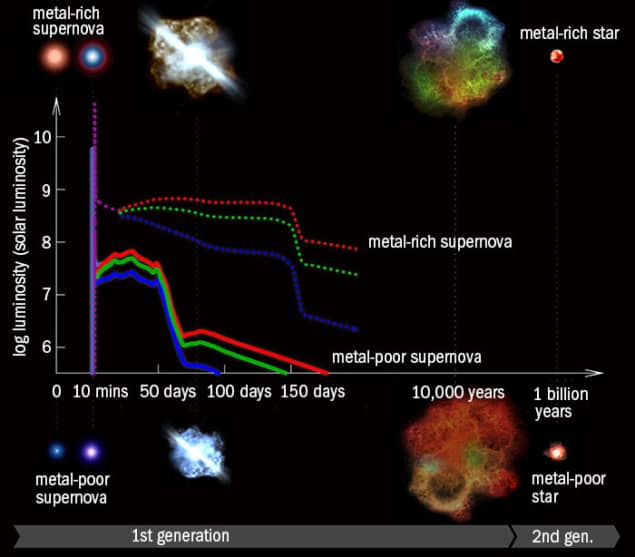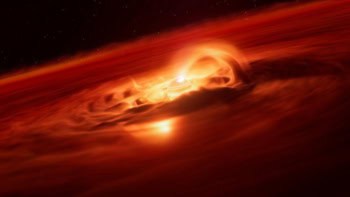
Astronomers hoping to spot “first-generation” supernovae explosions from the oldest and most distant stars in our universe should look out for the colour blue. So says an international team of researchers, which has discovered that the colour of the light from a supernova during a specific phase of its evolution is an indicator of its progenitor star’s elemental content. The work will help astronomers to directly detect the oldest stars, and their eventual supernovae explosions, in our universe.
Early days
Following the Big Bang, the universe mainly consisted of light elements such as hydrogen, helium and trace amounts of lithium. It was only 200 million years later, after the formation of the first massive stars, that heavier elements such as oxygen, nitrogen, carbon and iron – which astronomers all call “metals” – were forged in their extremely high-pressure centres. The first stars – called “population III” – are thought to have been so massive and unstable that they would have quickly burnt out and exploded in supernovae, which would have scattered the metals across the cosmos. Indeed, these first explosions will most likely have sown the seeds to form the next-generation “population II” stars, which are still “metal poor” compared with “population I” stars like the Sun.
Unfortunately, astronomers have yet to detect a true first population-III star or spot a first-generation supernova. Astronomers have been hunting for old stars, and the best evidence for them was found last year in an extremely bright and distant galaxy in the early universe. There are also some candidate stars in our own galaxy.
Old timers
The constituents and properties of the first-generation of stars and their supernova explosions are still a mystery, thanks to the lack of actual observations, especially when it comes to the supernovae. Studying first-generation supernovae would provide rare insights into the early universe, but astronomers have struggled to distinguish these early explosions from the ordinary supernovae we detect today.
Now though, Alexey Tolstov and Ken’ichi Nomoto from the Kavli Institute for the Physics and Mathematics of the Universe, together with colleagues, have identified characteristic differences between new and old supernovae, after experimenting with supernovae models based on stars with virtually no metals. Such stars make good candidates because they preserve their chemical abundance at the time of their formation.
“The explosions of first-generation stars have a great impact on subsequent star and galaxy formation. But first, we need a better understanding of how these explosions look like to discover this phenomenon in the near future,” says Tolstov, adding that the “most difficult thing here is the construction of reliable models based on our current studies and observations. Finding the photometric characteristics of metal-poor supernovae, I am very happy to make one more step to our understanding of the early universe.”
Blue hue
Just like ordinary supernovae, the light or luminosity of a first-generation supernova should also show the characteristic rise to a peak in brightness, followed by a steady decline – which astronomers call a “light curve”. Indeed, a bright flash would signal the shock waves that emerge from the star’s surface as its core collapses. This “shock breakout” is followed by a several-month-long “plateau” phase, where the luminosity remains relatively constant, before the slow exponential decay.
Nomoto’s team calculated the light curves of metal-poor supernovae, produced by blue supergiant stars, and “metal-rich” red supergiant stars. They found that both the shock-breakout and plateau phases are shorter, bluer and fainter for metal-poor supernovae in comparison to the metal-rich ones. The researchers conclude the blue light-curve could be used as an indicator of a low-metallicity star.
Unfortunately, the expansion of our universe makes it difficult to detect first star and supernova radiation, which is redshifted into the near-infrared wavelength. But the team says that upcoming large telescopes such as the James Webb Space Telescope, currently scheduled for launch in 2018, should be able to detect the distant light from first supernovae, and their method could be used to identify them. Their findings could also help to pick out low-metallicity supernovae in the nearby universe.
The work is published in the Astrophysical Journal.



